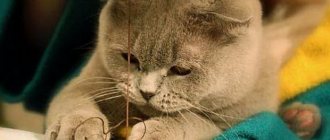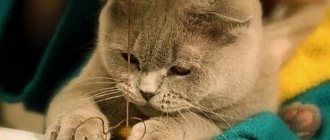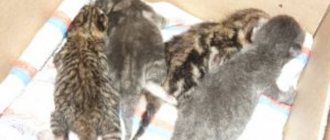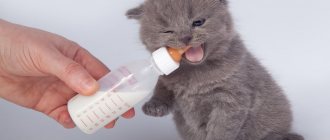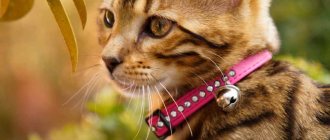You can’t describe the character of a British cat in a few words. It’s the same as saying about Napoleon’s life “he led France.” Only, the British are not French. They are proud, sometimes arrogant. We are talking about cats, about them - cats of the British breed.
Only this fact does not mean that representatives of the breed never want to be petted. They want it, but when they need it, and not at the moment when the owner takes it into his head. This cat is a personality. He has an opinion that must be taken into account. To understand what kind of character British cats have, you need to watch them a little, or better yet, live in the same house for several weeks.
Features of the appearance of the breed
Representatives of the British breed are distinguished by their stockiness and unusual plush fur. Pets come in medium and large sizes. They are beautifully built and have good muscles. The fur does not adhere to the body, which is why pets look like plush toys. At the same time, it has a uniform length; often the undercoat has a darker color than the main shade of the coat. The limbs are short but strong.
The British breed is characterized by a large head with pronounced cheekbones. The eyes of the pets are wide open, the nose is straight, the ears are quite short, because of this the muzzle looks more rounded.
The color of the British is not only blue. Although mostly people have pets of this shade. Cats may not be the same color; uneven coloring of the coat is also allowed. Each shade has several variations, for example, lilac is divided into three types: light, medium, dark.
The British breed inspired Lewis Carroll to create the Cheshire Cat. The character was based on the wide and slightly smug muzzle of the British.
In fact, according to the breed standard, at least thirty types of colors are known:
- black;
- white;
- creamy;
- chocolate;
- lilac;
- ginger;
- tortoiseshell;
- marble;
- chinchilla;
- brindle;
- mackerel;
- smoky;
- tabby;
- spotted.
British Fold cat - character
The British Fold, or Scottish Fold, is a special type of cat. The character of the British Fold cat is close to ideal. They are distinguished by their speed of reaction and intelligence. They are easy to train, they can be trained, they quickly learn the rules of behavior in the house where they live, and rarely break them.
They can be started in families with children. The British Fold will find an approach to everyone. Experienced breeders advise even those who have a dog to purchase this cat.
This breed also has some behavioral features that are unusual for British Shorthairs. They desperately need the company of people and have a hard time with loneliness. To prevent the animal from becoming despondent, the presence of at least one family member is sufficient. But this behavior does not mean that Scottish Folds like to impose themselves on their owner, this is not the case. They will never caress and jump on your lap, demand attention, will not be the first to start communication, this is beneath their dignity.
Tea dictionary
| Aroma | Aroma |
| Boling water | Boiling water |
| Brew | Welding |
| To brew tea | Brew tea |
| Ceylonese tea | Ceylon tea |
| China | 1) China 2) Porcelain |
| China tea | Chinese tea |
| Cup | Cup |
| Curd | Kurd, custard |
| Darjeeling | Darjeeling (type of tea) |
| Earl Gray | Tea with bergamot |
| Green tea | Green tea |
| Herbal tea | Herb tea |
| Indian tea | Indian tea |
| Kettle | Kettle (for boiling water) |
| Lump (of sugar) | Sugar cube) |
| Milk | Milk |
| Mint tea | Tea with mint |
| Oolong | Ulung (type of tea) |
| Saucer | Saucer |
| To stir | Mix |
| Scone | Scone, classic English muffin |
| Strong tea | Strong tea |
| Sugar | Sugar |
| Taste | Taste |
| Tea house, tea shop | Tea house, teahouse |
| Tea leaves | Tea leaves |
| Tea strainer | Tea strainer |
| Teapot | Teapot, teapot |
| Teaspoon | Tea spoon |
| Weak tea, watery tea | Weak tea |
| White tea | White tea |
How common are angry Scottish cats?
Aggressive and unkind are two different concepts. First we need to define the concept of “evil”. Angry is when he rushes at people and animals with aggression, growls, hisses and himself is the instigator of scandals and skirmishes. This is truly a rarity for the Scots.
Much more often you can find an unaffected Scottish cat who does not want to sit in your arms, does not like stroking, and behaves too independently and aloof. There are many such Scots. If you force yourself too hard on them with hugs, you can get a slap in the face. If you don’t have enough of them, then they can become real friends who will follow you on your heels, but sit next to you, like dogs. These are the kind of cat dogs who are friends with you, but on their own terms.
Elena, owner of a Scottish cat: “The cat is 6 months old, she is harmful and angry. If you start petting her, she most often either kicks back or gets up and leaves. He allows himself to be stroked only when he is lying dozing, then he even purrs with pleasure and stretches out his paws. But the rest of the time it bites hard if you play with it with your hand. I think a certain detachment and self-esteem is a feature of the breed.”
According to the rules, aggressive cats must be removed from breeding, because Scottish cat aggression is a breed defect that is inherited.
Irina, .
Scots, as a rule, do not have pure aggression, as described in the example above. But many of them don't like hands. Such cats will not allow you to do whatever the owner wants with them. So keep in mind that if you want a pet cat pillow that you can cuddle and pet whenever you want, this is not about the Scots. However, they know how to be affectionate. But only when they themselves need it. Be patient and wait.
Character traits
The character of the British is formed before one and a half years. If you miss time, it will be difficult to re-educate the cat.
The British breed has a special temperament. Cats do not tolerate humiliation and rudeness. With the right approach, they behave in a dignified manner, do not destroy the house, do not bite, or spoil things. You cannot limit their freedom by trying to grab them and carry them in your arms all the time. If the owner shows aggression towards the pet, then in the future the animal will hide and may even refuse food.
The pet will not show its owners weaknesses. He will not take revenge, like representatives of another breed, by tearing off wallpaper or ruining shoes. The British may spend a lot of time at home alone. But, despite their independence, they need attention and affection.
Representatives of the British breed are extremely patient; they do not react to minor mischief. Therefore, they get along well with all the inhabitants of the house. But if a cat is hurt, it will defend itself by using its teeth or claws.
About activity
The character of British kittens, like cats, can actually be reserved and sometimes even cold, but this does not in any way affect their activity. The British sleep a lot, but in their free time they will do what they want: run, jump, play. The exception in this case is only older representatives of the breed. Pets that have access to the street are more active. They are interested in everything around them: leaves, butterflies, flowers, so cats can spend hours on end outside. If there are several cats in the family, then additional activity will be provided. This is very good, since active animals have much fewer health problems.
Important! To prevent your cat from lying around in the apartment, you should play with him from time to time and offer him some options for useful ways to spend his waking hours.
How to raise a cat - habit formation, punishment, praise
Habits, unlike character, are formed throughout the pet’s life. Therefore, owners, with a little effort, can raise a cat correctly. The main thing is to immediately let your pet know who is in charge in the house.
The British are considered very clean. Kids imitate their mothers in everything, adopting her good manners. So, in order to accustom a kitten to the tray, a couple of days are enough. Adults regularly wash themselves and clean their fur. But at the same time, they don’t like it when their owners start fiddling with their fur.
Bad habits
British cats love to drop objects from heights. They like to watch the process of falling. As soon as the owners notice this prank, they should immediately scold the animal. To wean your pet from climbing into prohibited places, you need to treat the surfaces with a special product.
A kitten under four months of age may bite and scratch as it is teething. If this continues into adulthood, then this indicates improper upbringing. Therefore, it is worth initially giving the British toys that can be bitten instead of the owners’ hands.
The most harmless bad habit is checking bags and packages. It is difficult to wean your pet off of this, but it is worth scolding him for such tricks so that a reflex is developed.
Should a Briton be punished or praised?
If a pet has committed an offense, then you need to scold it immediately. Otherwise, he will not understand the essence of the claims. Moreover, the British will harbor a grudge and prefer to be as far away from you as possible.
The carrot and stick rule works with animals, as with people. That is, the animal will develop reflexes not only to punishment, but also to praise. It is advisable to notice positive changes in the cat’s behavior by talking about it out loud.
British habits
The British quickly get used to relieving themselves in a litter box and following the rules of living together. Kittens adopt basic habits from their mother. Therefore, it is important that she is also well brought up.
British cats are fans of cleanliness. The owner will have to ensure that there is always fresh filler in the tray. Otherwise, these aristocrats would prefer to go to the toilet on the owner’s bed. In the same way they express dissatisfaction with any reason. Representatives of the breed also do not like sudden changes in the type of filler.
British cats are also picky eaters. They often refuse food, waiting to be given their favorite treat.
The British devote a lot of time to grooming their fur. They can groom themselves for hours to get their coat looking perfect. This is a way for cats to relieve stress at the same time. Monotonous actions help them calm down and relax.
If the owner picks up the pet after it has been “washed,” the Briton will begin to lick itself again, eliminating hand odor. This feature must be taken into account so as not to cause inconvenience to the animal.
For your information. To prevent fur from accumulating in the stomach, British cats are periodically given malt paste. It gently cleanses the gastrointestinal tract without causing discomfort.
The majority of British cats behave very quietly. Pets rarely meow - more or less loud sounds can only be heard during the mating season. However, there are quite talkative British people who like to “talk” with the owner.
Many British cats make excellent hunters. After all, once upon a time the British bred them not for beauty, but to exterminate rodents. Not only mice, but also birds, lizards, moles and frogs can become prey. If there is nothing “under your paw”, flies or beetles will do.
After a successful hunt, a British cat will definitely come running to its owner to show off its trophy. But his pet will not eat. For him, the process is important, not the result.
It happens that a Briton does not pay any attention to game. Most likely, he is tired or in an inappropriate mood.
Aggressive cat: what to do and where to run
Cats are very sensitive creatures with a subtle psychology, so their behavior is significantly influenced by external factors, especially strong emotions such as fear.
A cat that is afraid of something takes a characteristic pose - it presses its ears tightly to its head and moves them back, presses its head and body to the ground, tries to become more invisible, in many cases the animal simply tries to run away.
If it doesn’t run away, it tries to defend itself. A cat that is ready to defend itself looks like this - it raises its paws and swings them, makes sounds similar to spitting, hisses, its fur stands on end (especially on the tail, head and back), its back arches and the animal moves sideways forward, so a cat tries to show its superiority (including in size) and intimidate the enemy.
In most cases, fear is the main cause of aggression in cats. If your pet is timid, you should never deliberately provoke fear; you should also ask your friends and acquaintances to approach the animal slowly, not abruptly, and say kind words as they do so. Only in this way can possible aggression on his part be neutralized.
If the cat is ready to attack, is aggressive, you can spray water on it from a spray bottle, this will cool its ardor. If an animal scratches a smooth surface out of despair, it means that it has lost control of the situation. In this case, you need to put some kind of rug on the cat so that she can sharpen her claws on it, or wrap her in a warm cloth - this way the cat will calm down faster.
Another reason for cat aggression is defense of territory. If there are several animals living in your home, especially if you are the owner of several cats that have reached sexual maturity, they may begin to fight for leadership. To prevent this from happening, introduce the cats correctly in the first days.
The animal that lived with you before should definitely receive more attention - this way it will not feel threatened and will not become jealous. As a rule, cats that live together eat from the same bowls and use the same litter box, but this can cause aggression. Cat utensils should be separated as soon as you notice that the animals are demonstratively avoiding the litter box or fighting around the bowls.
Different smells of animals can cause them to fight, so the manifestation of aggression of one pet towards another can be reduced by bathing them with the same shampoo or spraying them with the same cologne.
Neutered cats, as a rule, are less aggressive, and even sworn enemies can be reconciled. But it is better to castrate animals between the ages of seven months and 1 year, until they acquire the habit of showing aggression and marking territory.
Often those who keep cats confuse their bites with aggression. Small kittens may bite you because their jaws itch (due to teething). Invite them to chew bones, but only those that they cannot chew, or large pieces of meat. Never feed bones from small animals and birds, or chicken bones, as kittens can chew them, causing damage to the gastrointestinal tract.
Often, when the owner tries to pet his pet, he may begin to bite, especially if you want to scratch the cat’s tummy (the stomach for cats is the most vulnerable place, if the animal allows you to scratch its tummy, it means it is subordinate to you and completely trusts you). However, this does not always mean that the cat is aggressive; most likely, your pet is simply not in the mood for communication at the moment or she does not like your affection.
Under no circumstances should you hit cats that show aggression - this will only make the situation worse. If possible, you need to eliminate the cause of the aggression and cool the animal’s ardor with a stream of water.
The following method may also help. You've probably seen how cats behave during fights (swinging their paws at each other, hissing) or mother cats with their children (ruffling them and holding them by the withers). You must do the same - lightly shake the animal by the scruff of the neck, lightly tap it on the nose with your finger, imitate the waving of cats' paws during a fight, hiss at it menacingly and be sure to look the cat in the eyes, since the one who looks away first will “lose” - These are the cat “rules”. You must ensure that your pet looks away, he will become somewhat confused, begin to hesitate, may begin to leave or lick himself - this all means that the animal has recognized you as the leader.
Did you like the article? Click the button and share with your friends! Let there be more happy people and cats!
brit-cats.ru
Rules of education
British cats have been raised since early childhood. This breed is quite stubborn and conservative. It will be very difficult to retrain her as an adult.
After a kitten appears in the house, you must:
- introduce him to the new home and all its inhabitants;
- show where the tray, places for eating and sleeping are located;
- gradually accustom to hygiene procedures;
- bring your pet to the scratching post so that he doesn’t start spoiling things.
Immediately set restrictions. For example, if a person does not want an adult Briton to sleep on the master's bed, the same should not be allowed for a kitten. All family members must comply with the prohibitions, otherwise no result should be expected.
If a Briton makes mistakes, there is no need to shout at him, much less hit him. It is enough to say in a firm voice “No!” and lightly scold with the words “bad”, “naughty”, etc. Soon the kitten will understand what his mistake was and will try not to make it again.
While the British cat is learning good manners, it is better to remove all “temptations”:
- move the furniture so that it covers the wallpaper;
- raise the curtains on which the kitten can swing;
- treat with a special spray the places where the Briton gets used to going to the toilet (except for the litter tray);
- remove indoor flowers from reach, lubricate the leaves with lemon juice or another non-toxic substance.
For your information. If your kitten constantly eats flowers, you should contact your veterinarian. Perhaps your pet lacks vitamins and minerals.
The scratching post is installed in an accessible place. The kitten is brought to her every time he tries to tear up the furniture. For correct actions, the British are rewarded with sincere praise and their favorite treat.
If you show patience and perseverance, the kitten will grow into a well-mannered pet with noble manners.
How to bathe a cat
The British are clean, but they still need to be bathed sometimes. To do this, you must use special tools and follow the following rules:
- the pet should be placed in a basin filled one third with warm water;
- When applying shampoo, you should support the cat under the neck;
- The soap product must be washed completely; a shower and a comb may be useful for this.
After bathing, the animal must be wrapped to dry the fur. When it dries, you can comb it carefully.
Tender and affectionate British chinchilla
The British Chinchilla is a variety of the British breed that was created by crossing the British and Persian breeds. Usually this breed is chosen by those who are captivated by the beauty of the British, but are confused by their rebellious nature.
The chinchilla is people-oriented, has a good disposition and an easy-going character, which was passed on to it from the Persians, and it inherited intelligence and intelligence from the British.
Representatives of this breed love to cuddle and play with their owner; they will be able to establish relationships with all family members, even children, as well as animals. It is these character traits and qualities that make chinchillas a favorite.
British cats are distinguished by aristocracy and arrogance, independence and touchiness; they rarely show their feelings, so they can rarely be seen in an aggressive state or affectionate towards their owner. When getting a cat of this breed, you need to remember that it will always consider itself equal to a person.
Description
The external characteristics of these animals are as follows:
- A rounded head, large cheeks, a straight and short nose, low-set small ears, large open eyes, most often golden in color.
- A muscular body with wide bones, a wide torso and a massive back, short limbs, the weight of females is on average five kilograms, and in males it can reach up to eight.
- Thick shiny fur. There are short-haired and long-haired Britons, the former have plush and delicate fur, the latter have a good undercoat and gorgeous pubescence of the tail, collar and panties.
- Two or one color, the most common are black, blue white, lilac, cream and red cats. There are also tabby and ticked specimens.
If an animal has too pronounced antler caps, a long hooked nose, or sharp facial features, this is considered a fault.
Your pet is shedding - it doesn't hurt to be careful
In addition to the reasons already mentioned that provoke molting in a cat, more serious events may also occur.
Most often, owners pay attention to off-season shedding in winter, immediately starting to worry.
However, in most cases there is no reason for this, since in winter a British cat receives less vitamins, warmth and care. This is what causes the British cat to begin to actively shed.
In addition, you can name several more reasons when a pet sheds:
- stressful situations: in most cases this is associated with moving, undergoing operations or long-term illnesses;
- childbirth: in addition to the fact that the pregnancy process itself takes away strength, babies take almost all the nutrients from the mother, as a result of which she begins to shed;
- poor nutrition: cats react very sensitively to the slightest changes in their tiny bodies, so a healthy diet is very important;
- allergic reactions: most often occurs due to the British intolerance to certain types of dry food;
- hormonal surges: especially noticeable in breastfeeding women after childbirth;
- the presence of fungi and diseases.
What to feed a Briton
An adult cat needs to be fed at least twice a day, and a kitten at least four times. Your pet should have a balanced diet rich in vitamins. A cat's diet can be represented by:
- natural food:
- boiled meat without bones and skin;
- liver;
- eggs;
- porridge;
- fish;
- vegetables;
- dairy products.
- ready-made food.
When choosing food, you should pay attention to the line of professional food intended for the British breed.
The British are friendly, moderately affectionate, and treat all family members evenly. And yet, a British cat should not be owned by families with small children who are eager to cuddle the animal. This breed will not allow itself to be made into a toy; accordingly, it will hide in corners and turn into a frightened animal. If you take into account the wayward character of the cat, then she will repay you with affection.
Features of behavior and character of British women
When characterizing British cats, you need to understand that everything depends on their behavior. If you want to raise an animal, then you need to do this only up to a year, after which you won’t be able to change anything. Some owners complain about disobedience, not realizing that this is a consequence of poor upbringing . The British are proud enough that they will never ask a person for help. These are not the breeds that will cuddle or purr plaintively, trying to attract attention. These representatives will try to act independently.
While still babies, British kittens easily learn to use the litter box. The aristocratic breed does not allow them to shit wherever they have to. If you look at how a cat sleeps, you can involuntarily smile: on its back, in a ball, with its hind legs outstretched, on its side. The places to sleep are no less fun. Sometimes fluffy hides in places where you wouldn’t even think of looking for him - in a laundry basket or among soft toys. The habits of the British dog are often unpredictable, but this is dictated by the breed and some inherent instincts.
Idioms about tea
cup of tea - something preferred, desired, loved
Lit. "someone's cuppa"
Something pleasant, familiar, to taste:
Teaching children to read is just my cup of tea. — Teaching children to read is mine.
not one's cup of tea - something alien
Lit. "not anyone's" cuppa"
“Not my thing”, “not mine”:
Going to church, Mary said, was not her cup of tea. “She doesn’t like going to church,” said Mary.
tea party - 1) crazy party 2) simple and pleasant event
Lit. "tea party"
1. Loud, noisy, “crazy” party: There was a loud tea party going on in the pub when Jess came in. — When Jess entered, there was a noisy and riotous party in the pub.
2. An easy and pleasant event that does not cause fear or anxiety: The test was a real tea party. No sweat. — The exam was easy. No tension.
not for all the tea in China - not for anything in the world
Lit. “not for all the tea in China”
Not for any price, not for any price, never in life:
I wouldn't give up my car, not for all the tea in China. “I won’t give up my car for any wealth in the world.”
tempest in a teapot - storm in a glass of water
Lit. "storm in a teapot"
Also tempest in a teacup (“storm in a teacup”), tempest in a glass of water (“storm in a glass of water”), much ado about nothing (Shakespearean, “much ado about nothing”); in the British version - storm in a teacup. Overreaction to a minor event:
All that because a handful of the thousand invited guests didn't show up? What a tempest in a teapot! - And all this because a handful of thousands of invited guests did not show up? What a storm in a teacup!
aggressive behavior of the British
The problem is the following: my son has a cat, a lilac British one (taken from hand, without documents, so perhaps not entirely purebred). Adopted at the age of 1 month, hand-fed. Now the cat is 3.5 years old. At the age of about a year he was neutered. He eats dry Hills and likes to always have a lot of food in his bowl. He drinks water from a bucket and from the tap in the bathroom. Healthy, well-fed, does not go outside. Not vaccinated. The toilet is in a tray with wood filler, standing in the toilet. There are three people in the family (a son, his wife and a small child 2.5). The cat was always NOT tame - only his son recognized hands. Sometimes he allowed others (his wife, me, his daughter) to stroke him, but not for long. He was loyal to the child from birth, loved to sit and look at the baby, and sleep next to his crib. It was not given into the hands and is not given - it leaves or hides. The child is monitored, not allowing him to bother the cat or cause him pain. But the child is very big-booted. In the last year or so, the problem of aggression towards people has appeared. First - to strangers (friends come for tea - the cat rushes to his feet, growling, if someone wants to, say, go to the toilet). Then - the same behavior towards his wife - once he attacked her so that she locked herself in the room. Yesterday was the culmination (according to the stories, I didn’t see it myself). Only my son is at home (my wife and baby left for the summer the day before yesterday). In the evening, a neighbor came in, they were sitting in the kitchen, drinking lightly (really lightly, and only the son, the neighbor did not drink - they were celebrating the purchase of a new TV). The cat sat opposite in the corridor and hissed and purred. Then the neighbor needed to go to the toilet, the son got up from the stool to show the way - at that moment the cat rushed at his son, on his hand, and grabbed him with his claws and teeth. The son tried to remove it, taking it by the scruff of the neck with his other hand, but the cat turned around and cut his other hand. With difficulty, the son dragged him to another room, there they somehow shook him off and locked him there. At night, the son went into another room and closed the door, the cat had the whole apartment and the balcony at his disposal. This morning, when the son called and told all this, the cat was sitting under the closet, rumbling from there when the son approached. On his hands there was a bitten thumb and multiple deep scratches. Plus - shock - how did the cat attack him?! Before this, the son was the ONLY authority for the cat in the house. Now he’s thinking about what to do next with such a cat, projecting the possibility of such an attack on the child. Options - correct the behavior (how?!!), give it away, put it to sleep... (((I would be grateful for the advice, since I feel sorry for the cat. Can this behavior be corrected so as to eliminate it in the future? HOW should one behave in the event of such an attack?
How to tame a Brit
To tame anyone, you need to know everything about him. Or almost everything.
And don’t be fooled by the appearance of this cute kitten with huge, trusting eyes - yours are the same now.
The British cat is not a carefree lapdog, but a serious, respectful animal.
Let's leave the lyrical digressions and see what they are like - Their Majesties British Cats.
How to choose a new pet
Not in all situations there is a choice of whom to bring into the house, but if there is an opportunity to make a decision, then it is better to follow the recommendations of veterinarians and animal psychologists on this issue.
- The best option is kittens of the same age, approximately the same age or one to two months apart.
- Older cats, on the contrary, should not be mixed with young and active animals - calm and phlegmatic companions are suitable for them.
- A sexually mature, even sterilized, cat usually accepts a small kitten or teenager well - such animals have a well-developed maternal instinct, and they are able to take care of other people's kittens.
- Animals of different sexes must be sterilized - even experienced breeders do not keep fertile cats and female cats together, as frequent pregnancies and childbirth negatively affect the health of pets. Yes, and making friends with such a couple will be problematic.
- The most difficult thing is to achieve friendship between two male cats, regardless of their age, since males have much stronger instincts to protect their own territory.
— How many cats do you have and where are they from?
— There are seven cats. Their names are Kys, Lynx, Plush-Leksyush, Sir Max, Sanya the Cat, Sem-Sem (Semyon Semyonovich) and Penguy. Most of them are refuseniks and recruits.
Kysenka came to me at the age of three weeks, when he still couldn’t really eat. This was my first cat, my first pet. I got Lynx six months later. He is a conscientious receiver. The previous owners took it as a decoration for the sofa and returned it a week later - they say that the “decoration” does not want to decorate anything.
With Lexyusha I started as a felinologist. He came to me from very disadvantaged conditions. As a small kitten, he was taken into a family for a girl, who two months later had enough of playing and said: “Please take him back, mommy-daddy, and bring me the little one again.”
The cat was not thrown out, but left in a country house. From 3 to 9 months he sat in the attic - this means complete deprivation of communication at the age when the kitten is socializing and forming its view of the world and people. When he came to me, he had a lot of problems. Firstly, the “blockade syndrome”. He ate with terrible force until he vomited in the bowl. Secondly, the dust in the attic caused his paw pads to crack and bleed. We treated the little paws for a very long time. But the worst thing happened to his psyche. The kitten had a terrible fear of swinging. I don’t know what this girl was playing with him, but the kitten was afraid of hands. His nose was broken. He was afraid of people and did not know how to communicate with other animals. Sad story.
Then I worked as an assistant in a veterinary clinic and turned to my colleagues for help. They said that a behavior correction specialist was needed here. As it turned out, there are many such specialists in dogs, but in cats there are much fewer. We can say that 5 years ago they practically did not exist.
One of my friends advised me to contact Yulia Islamova. She is a specialist in behavior correction for dogs and cats. I invited her for a consultation. It was 4 hours that completely changed my life and my idea of cats. And at that time I considered myself an experienced cat lover. Thanks to her, Leksyusha came to his senses.
Establishing direct contact
Do not try to make a kitten happy with affection without making sure that the animal is ready for this. Start with simple steps:
- wait until the kitten itself shows interest in you - it begins to rub its cheeks against your legs, raising its tail high. Cats have glands on their cheeks and on the sides of their bodies, the secretions of which they use to mark their territory. By rubbing against the owner, pets mark you with their secret, which means they are ready for contact;
- before petting a cat approaching you, let it smell it to understand whether the animal is ready for close contact;
- Do not try to show affection towards the kitten prematurely. Take a comfortable position, wait until the pet comes to you.
WHO IS THIS CAT SUITABLE FOR?
Many lovers of British cats consider them to be the ideal cat. This cat has a kind and soulful look, a pleasant character, a variety of colors, and requires simple care, which makes it more and more popular.
The British cat received a succinctly characterizing name - “cat for a businessman . This all-understanding kitty is ideal for those who spend a lot of time working and are often away from home.
The Briton has a significant amount of Persian blood running through his veins. Therefore, he can be very restrained in expressing emotions, and sometimes even timid. This cat must be handled carefully and patiently.
conclusions
Perhaps one day an arrogant British cat will jump onto your lap and delight you with her simple song. Despite their genetically inherent independence and self-sufficiency, British cats have the ability to be grateful and love their caring owner.
Every owner dreams of stroking and holding their pet on their lap. But why doesn’t the cat sit in your arms in response to affection, and even scratch, bite and growl with displeasure? Here are the main reasons for this behavior and ways to tame an animal and make it affectionate and gentle.
A few words about breeds
Representatives of different breeds of cats can have very different personalities.
This fact is also worth paying attention to when choosing a new pet.
British shorthair cats and ragdolls have the most flexible character. Phlegmatic Britons usually find it easy to get along with most animals. Ragdolls get along well with representatives of any calm breeds, but can experience severe stress from being around active and assertive pets.
Persian cats can be more aggressive, but with the right approach and the absence of serious stress, they adapt well.
The least tolerant cats are Siamese cats and Sphynx cats.
Siamese are extremely jealous and cannot stand it when someone else gets the attention of their owners. They may enter into serious competition with the newly arrived animal.
And sphinxes are distinguished by mistrust and fearlessness, which is why they have difficulty accepting changes in their lives and do not respond very well to standard training methods.
How to properly hold a pet
First, it’s worth considering the basic rules for handling animals:
- Do not hold a cat against its will. If the animal doesn’t like it, it still won’t sit in your arms, so it’s better to let it go.
- Do not put too much pressure on your torso. If a cat is hurt, it will remember it and try to avoid such contact in the future.
- If your pet meows loudly, this is a signal that he is in pain or uncomfortable.
To pick up a pet, you should follow the following sequence:
- 1. Make sure the cat is free and friendly.
- 2. Approach him without sudden movements.
- 3. Call him affectionately, pet him or scratch him behind the ear.
- 4. If a cat purrs and looks into the eyes, this means that he is not against close communication with a person.
- 5. With one hand you need to grab the animal under the body by the front legs, with the other - by the hind legs and carefully lift it.
- 6. To make your pet feel comfortable, it is better to hold him close to you.
It is correct to hold a cat in your arms near your chest. You can’t restrict his movements, just lightly press him towards you. It is necessary to monitor the position of the pet's body; it should remain almost straight, without sagging or falling upside down. The cat's head should be slightly higher than its body. If the animal becomes uncomfortable, it will begin to break out of your hands, scratch or bite.
Choice: cat or cat
British Shorthairs (both males and females) value above all else a measured, shock-free life in conditions of maximum domestic comfort. The undoubted advantages of the British include their hypertrophied cleanliness: representatives of both sexes never tire of licking their bodies and demand clean rugs and cleaned trays.
Due to their natural intelligence, these cats quickly get used to the house and its routine, which is a clear advantage: a purebred Briton will not demand oatmeal for breakfast from the owner at sunrise, but will wait until he wakes up.
Both cats and cats (with ostentatious indifference) have a subtle mental organization, coupled with transcendental pride. Try to scold a Briton, especially if he doesn’t understand what exactly he did wrong, and he will show you his “fi” (and perhaps bite).
In general, the character of a British cat is almost independent of gender characteristics (everyone who breeds pedigree cats says this).
Should you get a second cat?
You can get a second cat only when the owners lack one animal in the house. If you have free time and enough finances, then why not? But it’s hardly wise to get a second cat just because the first cat is bored alone.
Cats are not pack animals, they do not need company (human attention is a separate issue; cats need it no less than dogs). But if the owners have very little free time, the house is empty all day long, then you can get a second cat so that the first one does not get bored without communication
Important: sometimes, despite the competent behavior of the owner, cats cannot be reconciled with each other. Animals, being in constant stress, begin to get sick (both physically and mentally)
In this situation, one of the animals will need to be placed in good hands - the family must be mentally prepared for such a development of events.
Feeding
By nature, any cat is a predator, so there should be variety in the diet. According to her instincts, she eats the entire portion of food given to her. You should not overfeed your pet to avoid causing problems with digestion and obesity. Lack of activity also affects weight gain.
Food should be either completely natural or ready-made. Mixing them is not recommended by veterinarians and cat breeding specialists. Cats prefer meat and meat products as natural food.
You should not choose fatty meats. You can include milk, kefir, cheese, vegetables, and various cereals in your diet. Special vitamin complexes can be used as supplements. If your cat receives ready-made food, it is better to choose a reliable manufacturer. Economy class food can be harmful to health.
— How else can people cause stress in a cat?
— Unfortunately, there are many ways. Cats communicate with each other and with us using body language. People do not always use it correctly, but cats read our signals in any case. We are accustomed to considering cats as something small and harmless, and few people would think that a cat has a personal space that must be respected. Therefore, cats are squeezed, disturbed by a sleeping animal, and held in their arms in a way that is unpleasant for him. Also, imagine the size ratio of a cat to a person - how it feels when someone steps on it and looms over it. The same thing with stroking. Often people raise their hand from above, and most cats, even those without fear of swinging, find this unpleasant.
Jan Steen. "Children teach a cat to dance." Fragment. 1660–1679
Many people like to grab a fluffy cat by the cheeks and kiss it. And the cat thinks that the man has gone crazy and is about to eat him.
While holding an animal in your arms, it is quite possible to bring your face to its muzzle. Moreover, the cat in such a situation will most likely rub its cheek. But you need to turn your head slightly, sideways - this way we reduce the level of anxiety.
If a cat is not allowed to rest peacefully, sooner or later it will begin to avoid people. In general, high places for observation and rest are important to them. Therefore, I am horrified every time apartments are furnished with low furniture and the animal has nowhere to go in such conditions.
Another way to easily stress a cat is by trying to punish it. There is no point in punishing cats. I’ll say more - it’s harmful! On the Internet, the most common advice is to stop dominant behavior. Do, they say, what cats and kittens do: take them by the collar and lift them up to your face. Or vice versa - press it to the ground. In short, to show who is boss here. However, the only thing that the cat will understand is that humans are a dangerous and unpredictable creature that should be feared.
Think about it: who does this to a cat? Does it grab you or throw you? Someone who is trying to kill her, such as a dog. What emotions should a cat feel towards a person after this?
Well, how, for example, does a table for a cat differ from another raised horizontal surface? Nothing. Sometimes this is the only such “comfortable” place in the house. If people are against having a cat on the table, there are plenty of ways to make the area unwelcome. However, if the owner swears, the cat will draw the only conclusion - don’t climb on the table in front of him. And accordingly, he will climb in in his absence. The owners are surprised: “Well, he understands that it’s impossible!” How and what does he understand? The animal understands that you do not approve. You are not there, there is no negative object - that means everything is possible.
Clara Peters. "Still life with carp, oysters, crayfish, roach and cat." First half of the 17th century
We must not forget that when prohibiting something, we must offer the cat an alternative. If you don't want him to climb on the table, offer him a window sill.
